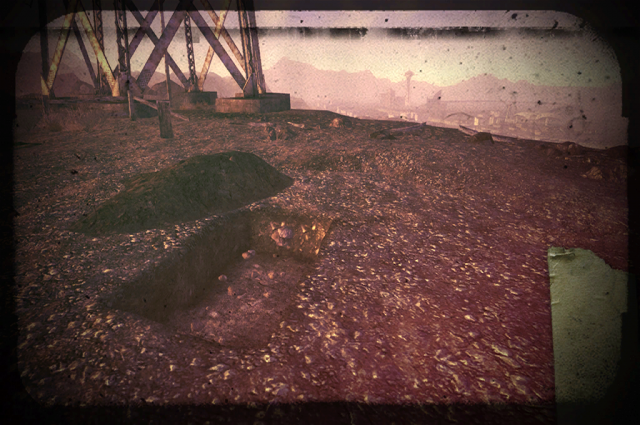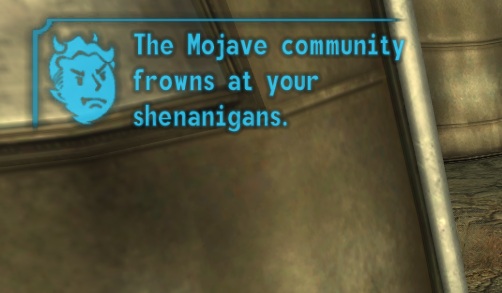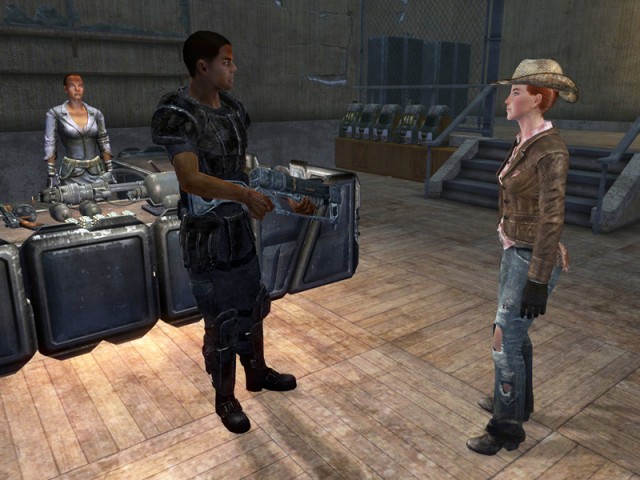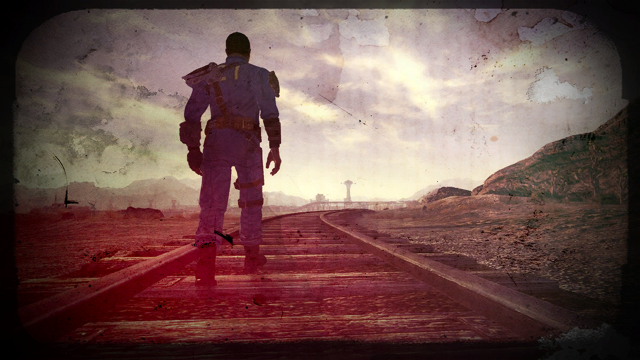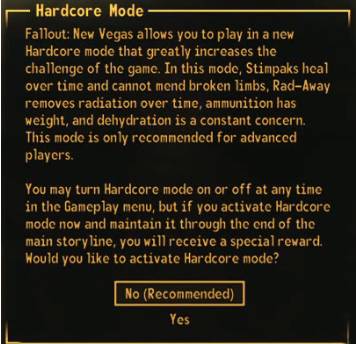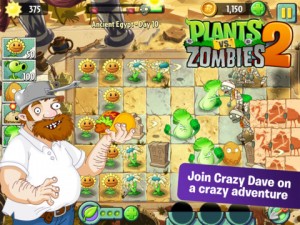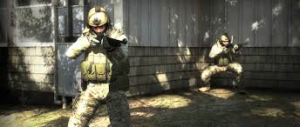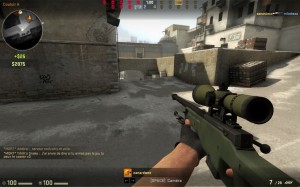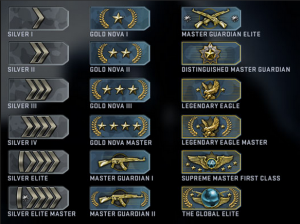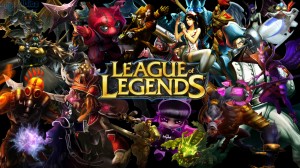In 2010, Bethesda released a “sidequel” to the highly successful Fallout 3, titled Fallout: New Vegas. This time it was developed by Obsidian Entertainment, many of whom had previously worked for Black Isle Studios on Fallout and Fallout 2. As a result, New Vegas became an amalgam of Fallout 3′s potential along with Fallout and Fallout 2′s spirit. Players start off as a Courier who returns from near-death and explore the Mojave Wasteland as they seek revenge.
Trailer: http://www.youtube.com/watch?v=l-x-1fm2cq8
The Lens of Judgment
The player’s actions are judged by the game through both the ‘karma’ and ‘faction reputation’ system. Their choices will change how NPCs react to the player’s presence.
‘Karma’ is a reflection of all good and evil choices the player makes during the game. Having a consistently negative karma can adversely affect the player. For instance, an NPC in the game named Cass can be the player’s companion throughout his or her adventures. If the player continues to have bad karma, Cass will eventually leave the player’s company.
Regarding ‘faction reputation’, certain choices the player makes can result in a ‘tug-of-war’ situation, such as completing the quest ‘Ghost Town Gunfight’ will raise the player’s reputation with Goodsprings, but decreases reputation with the Powder Gangers. Completing the quest ‘Run Goodsprings Run’ will have the opposite effect. As a result, a high rep with a faction or town may give certain benefits, such as gifts from the people of the town, while a low rep may lead to hits being taken out against the player. It can even give the player access to new areas in the game.
The Lens of Meaningful Choices
At certain points in the game, the player will be forced to make tough decisions. Based on the player’s own mentality, morality, and intentions, they have a few options to choose from in order to progress further into the game.
For instance, when meeting the NPC Boone for the first time, the player will undergo a quest called ‘One for My Baby’ where Boone will request the Courier to find the person who kidnapped his wife. The player is given the option to either painstakingly find the real culprit through interviewing the townsfolk and even breaking into a safe (resulting in loss of karma), or frame any one of the other townsfolk. Other alternative playthroughs can be done, but ultimately, the positive result is to have Boone, a skilled sniper, as a companion throughout the game.
In another quest called Birds of a Feather, the player is given the task of sending their companion Cass to her execution at the hands of the quest-giver. The player is now forced to make a choice to either lose a companion for monetary and XP gain or to enter a fairly difficult gunfight with the quest-giver and his gang, resulting in failing the quest but keeping Cass’ companionship.
The Lens of the Story Machine
From the two lenses above, the player’s actions and choices will change the political and environmental landscape of the Mojave Wasteland. As a result, the player will be given access to more avenues to advance further into the story. However, this is not restricted to the main storyline, as the player’s interactions with NPCs, including their companions, will allow them to involve themselves in the NPCs’ lives, hopefully making the player more invested in the inhabitants of the Mojave Wasteland.
Another way the player can affect the story is before the final battle at the Hoover Dam, where the player will have to choose to either support a specific faction or independently claim the territory of New Vegas. This is done through completing quests given by the specific faction in order to gain a positive reputation with them.
Whichever option the player chooses at every junction in the story will result in completely different endings. All the endings can be seen here: http://fallout.wikia.com/wiki/Fallout:_New_Vegas_endings
The Lens of Challenge
Hardcore mode is an optional setting in New Vegas which makes gameplay more realistic, which in turn makes things a bit tougher for the player. Effects include:
– ‘Stimpaks’ heal over time instead of instantly
– Ammunition has weight
– Companions can die
– The Courier must eat, drink, and have proper sleep cycles or they will suffer increasingly negative effects, up to immediate death
The Lens of the World
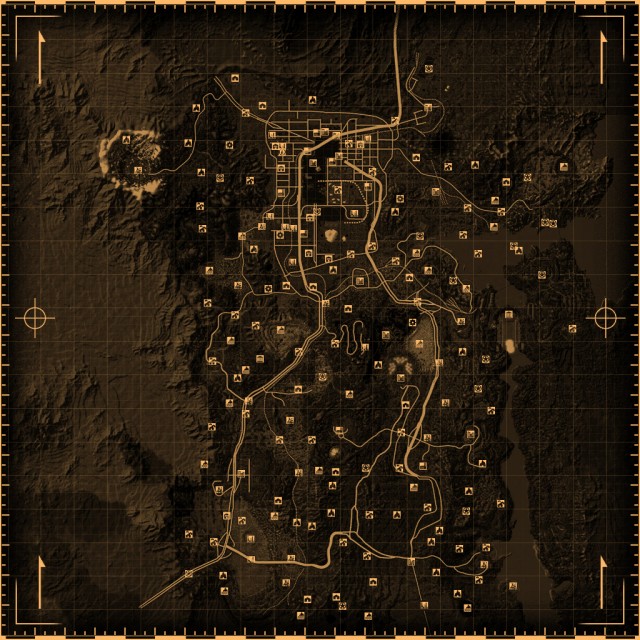 The world that New Vegas encompasses is essentially a world that is stuck in the 1940s, but flung forward in time where technology has progressed to the level of science fiction. Most of the planet is still a desolate wasteland and hasn’t recovered from the nuclear fallout. The Mojave Wasteland is home to giant bugs, ghouls, mutants, and the terrible Deathclaws. Finding clean water is a luxury as most of it is irradiated, and radiation medicine is as important as food.
The world that New Vegas encompasses is essentially a world that is stuck in the 1940s, but flung forward in time where technology has progressed to the level of science fiction. Most of the planet is still a desolate wasteland and hasn’t recovered from the nuclear fallout. The Mojave Wasteland is home to giant bugs, ghouls, mutants, and the terrible Deathclaws. Finding clean water is a luxury as most of it is irradiated, and radiation medicine is as important as food.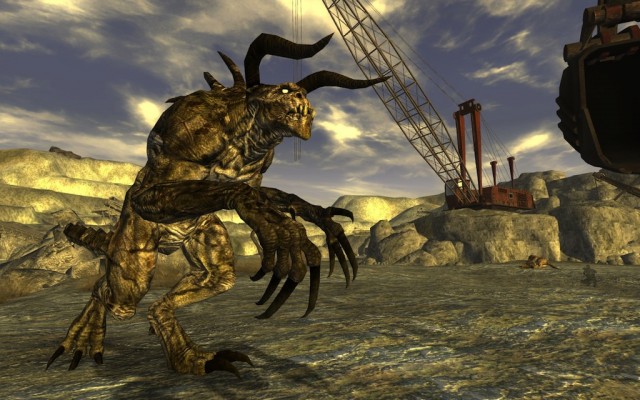
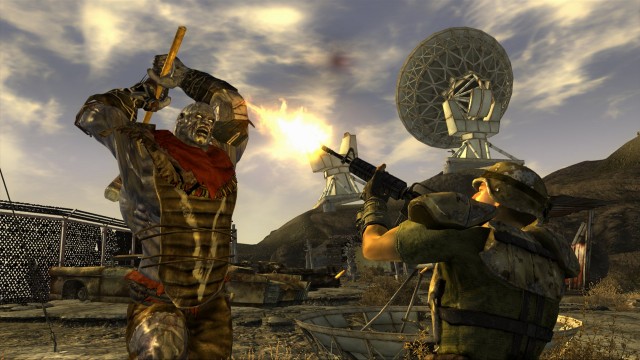
However, the focus of the Mojave is on the people who live and work there, who struggle everyday to see tomorrow. The player will experience their plight as The Courier is one of these survivors. They will hunt and scavenge for resources in order to fight another day. Considering the game is set in a post-apocalyptic Las Vegas, the inhabitants who visit there often indulge in hedonistic acts in order to forget their suffering. It is not unlike the Las Vegas in the real world, except there’s a casino/restaurant where a secret group of cannibals dressed in fancy garb reside.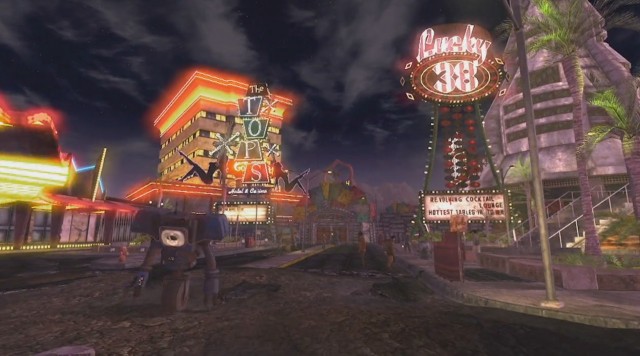
The world in Fallout is a dark and morbid place, but setting it in Las Vegas makes things much more lively as it steals the attention away from the horrors of the world, much like what videogames do.


